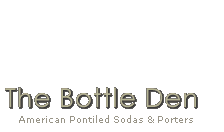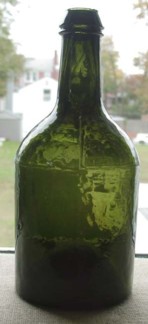Baltimore Druggists of 1845 offer Imported Waters...
Article III - King and Caspari Display Ads | back to Articles
by Wil Martindale
1845 is an exciting year for Baltimore soda collectors. John Boyd and Son were probably using a small open-pontiled soda along with their torpedos. William Coughlan may have introduced his flared-lip stubby soda this year. Cole & Chickering were showing their unique "octagonal" mineral water form.
According to Baltimore city directories, over 60 businesses were engaged in the production or distribution of some form of carbonated beverage between 1827 and 1847. Less than a dozen of these produced marked bottles that are known of today. In addition to these local products, foreign mineral waters were being imported. Two obscure Druggists in particular have left solid evidence of imported mineral waters in their product line, based on 1845 display ads.

First is Solomon King, who advertises "CONGRESS and PAVILION WATERS, fresh and genuine, by the box or dozen". From the ad, we presume that the water is shipped from the Saratoga area, but what kind of bottles were used? Were the waters shipped in marked or unmarked Saratoga cylinders that King could label as a distributor, or did King perhaps obtain bottles locally and ship them to Saratoga for filling there?
King may not have left behind tangible evidence of his Congress and Pavilion bottles, but he was not alone in the business of importing medicinal mineral waters...

Charles Caspari, advertised "SELTZER AND KISSENGER WATERS, Direct from the Springs in Germany" in the same 1845 Baltimore directory.
What kinds of bottles held these imported waters? Were they quarts, pints, half-pints or a combination of these? Were German bottles used, or is it possible that locally blown bottles were shipped to Germany to be filled there and returned?
There are no identifiable examples of mineral water bottles distributed by King or Caspari, but we can be relatively certain that the value of the bottles far exceeded that of their liquid contents. Wouldn't it make sense that large, established Spring owners would encourage foreign distributors to provide their own bottles for filling in order to avoid the high cost of providing expensive bottles (to many small business owners) that might never be returned?
Considering the efforts made to get local bottles returned, and the problems associated with the use and re-use of competitors bottles, it isn't difficult to imagine Baltmore glass being used to distribute New York and German spring water to Baltimore patrons. For it does seem to be Baltimore glass after all, not Saratoga or German glass, that most often turns up in Baltimore privies of the era.
These ideas or suggestions are mere conjecture--there is not enough solid evidence to draw any conclusions as to what kinds of bottles were used by Alcock, King and Caspari, or where they originated from. But we do know that the idea of fruit flavored mineral waters was being marketed to Baltimorians as early as 1829, and that by 1845, Baltimore Druggists were marketing imported mineral waters to their patrons.
It will be interesting to see what findings further research will uncover.


